《国际金融 I》作业答案
国际金融英文版课后答案
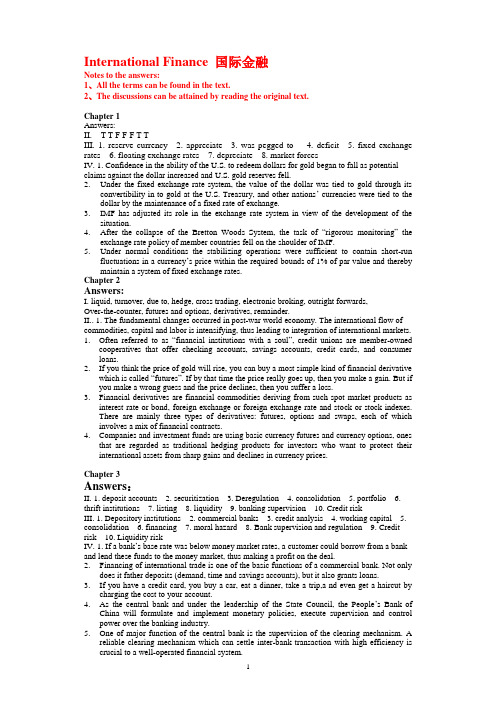
International Finance 国际金融Notes to the ans wers:1、All the terms can be found in the text.2、The discussions can be attained by reading the original text.Chapter 1Answers:II. T T F F F T TIII. 1. reserve currency 2. appreciate 3. was pegged to 4. deficit 5. fixed exchange rates 6. floating exchange rates 7. depreciate 8. market forcesIV. 1. Confidence in the ability of the U.S. to redeem dollars for gold began to fall as potential claims against the dollar increased and U.S. gold reserves fell.2.Under the fixed exchange rate system, the value of the dollar was tied to gold through itsconvertibility in to gold at the U.S. Treasury, and other nations’ currencies were tied to the dollar by the maintenance of a fixed rate of exchange.3.IMF has adjusted its role in the exchange rate system in view of the development of thesituation.4.After the collapse of the Bretton Woods System, the task of ―rigorous monitoring‖theexchange rate policy of member countries fell on the shoulder of IMF.5.Under normal conditions the stabilizing operations were sufficient to contain short-runfluctuations in a currency’s price within the required bounds of 1% of par value and thereby maintain a system of fixed exchange rates.Chapter 2Answers:I. liquid, turnover, due to, hedge, cross trading, electronic broking, outright forwards,Over-the-counter, futures and options, derivatives, remainder.II.. 1. The fundamental changes occurred in post-war world economy. The international flow of commodities, capital and labor is intensifying, thus leading to integration of international markets.1.Often referred to as ―financial institutions with a soul‖, credit unions are member-ownedcooperatives that offer checking accounts, savings accounts, credit cards, and consumer loans.2.If you think the price of gold will rise, you can buy a most simple kind of financial derivativewhich is called ―futures‖. If by that time the price really goes up, then you make a gain. But if you make a wrong guess and the price declines, then you suffer a loss.3.Financial derivatives are financial commodities deriving from such spot market products asinterest rate or bond, foreign exchange or foreign exchange rate and sto ck or stock indexes.There are mainly three types of derivatives: futures, options and swaps, each of which involves a mix of financial contracts.panies and investment funds are using basic currency futures and currency options, onesthat are regarded as traditional hedging products for investors who want to protect their international assets from sharp gains and declines in currency prices.Chapter 3Answers:II. 1. deposit accounts 2. securitization 3. Deregulation 4. consolidation 5. portfolio 6. thrift institutions 7. listing 8. liquidity 9. banking supervision 10. Credit riskIII. 1. Depository institutions 2. commercial banks 3. credit analysis 4. working capital 5. consolidation 6. financing 7. moral hazard 8. Bank supervision and regulation 9. Credit risk 10. Liquidity riskIV. 1. If a bank’s base rate was below money market rates, a customer could borrow from a bank and lend these funds to the money market, thus making a profit on the deal.2.Financing of international trade is one of the basic functions of a commercial bank. Not onlydoes it father deposits (demand, time and savings accounts), but it also grants loans.3.If you have a credit card, you buy a car, eat a dinner, take a trip,a nd even get a haircut bycharging the cost to your account.4.As the central bank and under the leadership of the State Council, the People’s Bank ofChina will formulate and implement monetary policies, execute supervision and control power over the banking industry.5.One of major function of the central bank is the supervision of the clearing mechanis m. Areliable clearing mechanis m which can settle inter-bank transaction with high efficiency is crucial to a well-operated financial system.Chapter 4 Ans wers:II. 1.integrity 2. pretext 3. released 4. produce 5. facilities 6. obliged 7. alleging 8. Claims 9. cleared 10. deliveryIII. 1. in favor of 2. consignment 3. undertaking, terms and conditions 4. cleared 5. regardless of 6. obliged to 7. undervalue arrangement 8. on the pretext of 9. refrain from 10. hinges onIV. 1. The objective of documentary credits is to facilitate international payment by making use of the financial expertise and credit worthiness of one or more banks.2.In compliance with your request, we have effected insurance on your behalf and debited youraccount with the premium in the amount of $1000.3.When an exporter is trading regularly with an importer, he will offer open account terms.4.Exporters usually insist on payment by cash in advance when they are trading with oldcustomers.5.Cash in advance means that the exporter is paid either when the importer places his order orwhen the goods are ready for shipment.Chapter 5.II.1. b 2. c 3. c 4. a 5. b 6. b 7. a 8. cIII. 1. guaranteed 2. without recourse 3. defaults 4. on the buyer’s account 5. is equivalent to 6. in question 7. devaluation 8. validity 9. discrepancy 10. inconsistent withChapter 6Answers:II. 1. open account, creditworthiness 2. demand 3. draw on, creditor 4. protest 5. schedule, discrepancies 6. acceptance 7. drawee 8. guranteedIII. 1. collecting bank 2. tenor 3. the proceeds 4. protest 5. deferred payment 6. presentation 7. the maturity date 8. a document of title 9. the shipping documents 10. transshipmentIV. 1. Documentary collection is a method by which the exporter authorizes the bank to collect money from the importer.2.When a draft is duly presented for acceptance or payment but the acceptance or paymentis refused, the draft is said to be dishonored.3.In the international money market, draft is a circulative and transferable instrument.Endorsement serves to transfer the title of a draft to the transferee.4.A clean bill of lading is favored by the buyer and the banks for financial settlementpurposes.5.Parcel post receipt is issued by the post office for goods sent by parcel post. It is both areceipt and evidence of dispatch and also the basis for claim and adjustment if there is any damage to or loss of parcels.Chapter 7II. financing, discounting, factoring, forfaiting, without recourse, accounts receivable, factor, trade obligations, promissory notes, trade receivables, specialized.III. 1. a cash flow disadvantage 2. without recourse 3. negotiable instruments 4. promissory notes 5. profit margin 6. at a discount, maturity, credit risk 7. A bill of exchange, A promissory noteIV. 1. When a bill is dishonored by non-acceptance or by non-payment, the holder then has an immediate right of recourse against the drawer and the endorsers.2.If a bill of lading is made out to bearer, it can be legally transferred without endorsement.3.The presenting bank should endeavor to ascertain the reasons non-payment ornon-acceptance and advise accordingly to the collecting bank.4.Any charges and expenses incurred by banks in connection with any action for protection o fthe goods will be for the account of the principal.5.Anyone who has a current account at a bank can use a cheque.Chapter EightStructure of the Foreign Exchange Market外汇市场的构成1. Key Terms1)foreign exchange:―Foreign exchange‖ refers t o money denominated in the currency of another nation or group of nations.2)payment“payment”is the transmission of an instruction to transfer value that results from a transaction in the economy.3)settlement―settlement‖ is the final and uncondit ional transfer of the value specified in a payment instruction.2. True or False1) true 2) true 3) true 4) true1)Tell the reasons why the dollar is the market's most widely tradedcurrency?key points: U.S.A economic background; the leadership of USD in the world economy ; the role it plays in investment , trade, etc.2)What kind of market is the foreign exchange market?Make reference to the following parts:(8.7 The Market Is Made Up of An International Network of Dealers)Chapter 9Instruments交易工具1. Key Terms1) spot transactionA spot transaction is a straightforward (or ―outright‖) exchange of one currency for another. The spot rate is the current market price, the benchmark price.Spot transactions do not require immediate settlement, or payment ―on the spot.‖ By convention, the settlement date, or ―value date,‖is the second business day after the ―deal date‖ (or ―trade date‖) on which the transaction is agreed to by the two traders. The two-day period provides ample time for the two parties to confirm the agreement and arrange the clearing and necessary debiting and crediting of bank accounts in various international locations.2) American termsThe phrase ―American terms‖means a direct quote from the point of view of someone located in the United States. For the dollar, that means that the rate is quoted in variable amounts of U.S. dollars and cents per one unit of foreign currency (e.g., $1.2270 per Euro).3) outright forward transactionAn outright forward transaction, like a spot transaction, is a straightforward single purchase/ sale of one currency for another. The only difference is that spot is settled, or delivered, on a value date no later than two business days after the deal date, while outright forward is settled on any pre-agreed date three or more business days after the deal date. Dealers use the term ―outright forward‖ to make clear that it is a single purchase or sale on a future date, and not part of an ―FX swap‖.4) FX swapAn FX swap has two separate legs settling on two different value dates, even though it is arranged as a single transaction and is recorded in the turnover statistics as a single transaction. The two counterparties agree to exchange two currencies at a particular rate on one date (the ―near date‖) and to reverse payments, almost always at a different rate, on a specified sub sequent date (the ―far date‖). Effectively, it is a spot transaction and an outright forward transaction going in opposite directions, or else two outright forwards with different settlement dates, and going in opposite directions. If both dates are less than one month from the deal date, it is a ―short-dated swap‖; if one or both dates are one month or more from the deal date, it is a ―forward swap.‖5) put-call parity―Put-call parity‖says that the price of a European put (or call) option can be deduced from the price of a European call (or put) option on the same currency, with the same strike price and expiration. When the strike price is the same as the forward rate (an ―at-the-money‖forward), the put and the call will be equal in value. When the strike price is not the same as the forward price, the difference between the value of the put and the value of the call will equal the difference in the present values of the two currencies.2. True or False1) true 2) true 3) true3. Cloze1) Traders in the market thus know that for any currency pair, if the basecurrency earns a higher interest rate than the terms currency, the currency will trade at a forward discount, or below the spot rate; and if the base currency earns a lower interest rate than the terms currency, the base currency will trade at a forward premium, or above the spot rate. Whichever side of the transaction the trader is on, the trader won't gain (or lose) from both the interest rate differential and the forward premium/discount. A trader who loses on the interest rate will earn the forward premium, and vice versa.2) A call option is the right, but not the obligation, to buy the underlyingcurrency, and a put option is the right, but not the obligation, to sellthe underlying currency. All currency option trades involve two sides—the purchase of one currency and the sale of another—so that a put to sell pounds sterling for dollars at a certain price is also a call to buy dollars for pounds sterling at that price. The purchased currency is the call side of the trade, and the sold currency is the put side of the trade. The party who purchases the option is the holder or buyer, and the party who creates the option is the seller or writer. The price at which the underlying currency may be bought or sold is the exercise , or strike, price. The option premium is the price of the option that the buyer pays to the writer. In exchange for paying the option premium up front, the buyer gains insurance against adverse movements in the underlying spot exchange rate while retaining the opportunity to benefit from favorable movements. The option writer, on the other hand, is exposed to unbounded risk—although the writer can (and typically does) seek to protect himself through hedging or offsetting transactions.4. Discussions1)What is a derivate financial instrument? Why is traded?2)Discuss the differences between forward and futures markets in foreigncurrency.3)What advantages do foreign currency futures have over foreigncurrency options?4)What is meant if an option is ―in the money‖, ―out of the money‖,or ―atthe money‖?5)What major international contracts are traded on the ChicagoMercantile Exchange ? Philadelphia Stock Exchange?Chapter 10Managing Risk in Foreign Exchange Trading外汇市场交易的风险管理1. Key Terms1) Market riskMarket risk, in simplest terms, is price risk, or ―exposure to (adverse)price change.‖ For a dealer in foreign exchange, two major elements of market risk are exchange rate risk and interest rate risk—that is, risks of adverse change in a currency rate or in an interest rate.2) VARVAR estimates the potential loss from market risk across an entire portfolio, using probability concepts. It seeks to identify the fundamental risks that the portfolio contains, so that the portfolio can be decomposed into underlying risk factors that can be quantified and managed. Employing standard statistical techniques widely used in other fields, and based in part on past experience, VAR can be used to estimate the daily statistical variance, or standard deviation, or volatility, of the entire portfolio. On the basis of that estimate of variance, it is possible to estimate the expected loss from adverse price movements with a specified probability over a particular period of time (usually a day).3) credit riskCredit risk, inherent in all banking activities, arises from the possibility that the counterparty to a contract cannot or will not make the agreed payment at maturity. When an institution provides credit, whatever the form, it expects to be repaid. When a bank or other dealing institution enters a foreign exchange contract, it faces a risk that the counterparty will not perform according to the provisions of the contract. Between the time of the deal and the time of thesettlement, be it a matter of hours, days, or months, there is an extension of credit by both parties and an acceptance of credit risk by the banks or other financial institutions involved. As in the case of market risk, credit risk is one of the fundamental risks to be monitored and controlled in foreign exchange trading.4) legal risksThere are legal risks, or the risk of loss that a contract cannot be enforced, which may occur, for example, because the counterparty is not legally capable of making the binding agreement, or because of insufficient documentation or a contract in conflict with statutes or regulatory policy.2. True or False1)True 2) true3. Translation1) Broadly speaking, the risks in trading foreign exchange are the same asthose in marketing other financial products. These risks can be categorized and subdivided in any number of ways, depending on the particular focus desired and the degree of detail sought. Here, the focus is on two of the basic categories of risk—market risk and credit risk (including settlement risk and sovereign risk)—as they apply to foreign exchange trading. Note is also taken of some other important risks in foreign exchange trading—liquidity risk, legal risk, and operational risk2) It was noted that foreign exchange trading is subject to a particular form ofcredit risk known as settlement risk or Herstatt risk, which stems in part from the fact that the two legs of a foreign exchange transaction are often settled in two different time zones, with different business hours. Also noted was the fact that market participants and central banks have undertaken considerable initiatives in recent years to reduce Herstatt risk.4. Discussions2)Discuss the way how V AR works in measuring and managing marketrisk?3)Why are banks so interested in political or country risk?4)Discuss other forms of risks which you know in foreign exchange. Chapter 11The Determination of Exchange Rates汇率的决定1. Key Terms1) PPPPurchasing Power Parity (PPP) theory holds that in the long run, exchange rates will adjust to equalize the relative purchasing power of currencies. This concept follows from the law of one price, which holds that in competitive markets, identical goods will sell for identical prices when valued in the same currency.2) the law of one priceThe law of one price relates to an individual product. A generalization of that law is the absolute version of PPP, the proposition that exchange rates will equate nations' overall price levels.3) FEER―fundamental equilibrium exchange rate,‖ or FEER,envisaged as the equilibrium exchange rate that would reconcile a nation's internal and external balance. In that system, each country would commit itself to a macroeconomicstrategy designed to lead, in the medium term, to ―internal balance‖—defined as unemployment at the natural rate and minimal inflation—and to ―external balance‖—defined as achieving the targeted current account balance. Each country would be committed to holding its exchange rate within a band or target zone around the FEER, or the level needed to reconcile internal and external balance during the intervening adjustment period.4) monetary approachThe monetary approach to exchange rate determination is based on the proposition that exchange rates are established through the process of balancing the total supply of, and the total demand for, the national money in each nation. The premise is that the supply of money can be controlled by the nation's monetary authorities, and that the demand for money has a stable and predictable linkage to a few key variables, including an inverse relationship to the interest rate—that is, the higher the interest rate, the smaller the demand for money.5) portfolio balance approachThe portfolio balance approach takes a shorter-term view of exchange rates and broadens the focus from the demand and supply conditions for money to take account of the demand and supply conditions for other financial assets as well. Unlike the monetary approach, the portfolio balance approach assumes that domestic and foreign bonds are not perfect substitutes. According to the portfolio balance theory in its simplest form, firms and individuals balance their portfolios among domestic money, domestic bonds, and foreign currency bonds, and they modify their portfolios as conditions change. It is the process of equilibrating the total demand for, and supply of, financial assets in each country that determines the exchange rate.2. True or False1) true 2) true3. Cloze1)PPP is based in part on some unrealistic assumptions: that goods are identical; that all goods are tradable; that there are no transportationcosts, information gaps, taxes, tariffs, or restrictions of trade; and—implicitly and importantly—that exchange rates are influenced only byrelative inflation rates. But contrary to the implicit PPP assumption,exchange rates also can change for reasons other than differences ininflation rates. Real exchange rates can and do change significantly overtime, because of such things as major shifts in productivitygrowth, advances in technology, shifts in factor supplies, changes inmarket structure, commodity shocks, shortage, and booms.2)Each individual and firm chooses a portfolio to suit its needs, based on a variety of considerations—the holder's wealth and tastes, the level ofdomestic and foreign interest rates, expectations of future inflation,interest rates, and so on. Any significant change in the underlying factorswill cause the holder to adjust his portfolio and seek a new equilibrium.These actions to balance portfolios will influence exchange rates.4. Discussions1)How does the purchasing power parity work?2)Describe and discuss one model for forecasting foreign exchange rates.3)Make commends on how good are the various approaches mentioned in the chapter.4)Central banks occasionally intervene in foreign exchange markets. Discuss the purpose of such intervention. How effective is intervention?Chapter 12The Financial Markets金融市场1. Key Terms1)money marketThe money market is really a market for short-term credit, or the option to use someone else's money for a period of time in return for the payment of interest. The money market helps the participants in the economic process cope with routine financial uncertainties. It assists in bridging the differences in the timing of payments and receipts that arise in a market economy.2)capital marketMarkets dealing in instruments with maturities that exceed one year are often referred to as capital markets.3)primary marketThe term ―primary market‖ applies to the original issuance of a credit market instrument. There are a variety of techniques for such sales, including auctions, posting of rates, direct placement, and active customer contacts by a salesperson specializing in the instrument4) secondary marketOnce a debt instrument has been issued, the purchaser may be able to resell it before maturity in a ―secondary market.‖ Again, a number of techniques are available for bringing together potential buyers and sellers of existing debt instruments. They include various types of formal exchanges, informal telephone dealer markets, and electronic trading through bids and offers on computer screens. Often, the same firms that provide primary marketing services help to create or ―make‖ secondary markets.5)RPsIn addition to making outright purchases and sales in the secondary market, entities with money to invest for a brief period can acquire a security temporarily, and holders of debt instruments can borrow short term by selling securities temporarily. These two types of transactions are repurchase agree-ments (RPs) and reverse RPs,respectively. In the wholesale market, banks and government securities dealers offer RPs at competitive rates of return by selling securities under contracts providing for their repurchase from one day to several months later6)BAs 7)CDs (reference to 13.1)8) EurodollarEurodollars are U.S. dollar deposits at banking offices in a country other than the United States.9) EurobankEurobanks—banks dealing in Eurodollar or some other nonlocal currency deposits, including foreign branches of U.S. banks— originally held deposits almost exclusively in Europe, primarily London. While most such deposits are still held in Europe, they are also held in such places as the Bahamas, Bahrain, Canada, the Cayman Islands, Hong Kong, Singapore, and Tokyo, as well as other parts of the world.10)LIBOR (reference to 13.2.2 Certificates of Deposit)London inter-bank offer rate11)mortgage-backed securities12)Eurobond market (details make reference to13.3.3 )The Eurobond market, centered in London, is an offshore market in intermediate- and long-term debt issues. It serves as a source of capital for multinational corporations and for foreign governments. It developed after the United States instituted the interest equalization tax in 1963 to stem capital outflows inspired by relatively low U.S. interest rates.2. True or False1) true 2) true 3) true3. Discussions1) Describe the characteristics of Interest Rate Swap and the role of it in thebank-related financial market.2) What risks are encountered in the swaps markets?3) Discuss one or two specific examples of derivative products and their use.4. Translations1) Markets dealing in instruments with maturities that exceed one year are often referred to as capital markets, since credit to finance investments in new capital would generally be needed for more than one year. The time division is arbitrary. A long-term project can be started with short-term credit, with additional instruments may need to be renewed before a project is completed. Debt instruments that differ in maturity share other characteristics. Hence, the term ―capital market‖ could be –and occasionally is applied to some shorter maturity transactions.2) The secondary market for Treasure securities consists of a network of dealers, brokers, and investors who effect transactions either by telephone or electronically. Telephone trades are generally between dealers and their customers. Electronics trading is arranged through screen-based systems provided by some of the dealers to their customers. It allows selected trades to take place without a conversation. When dealers trade with each other, they generally use brokers. Brokers provide information on screen, but the final trades are made bytelephone.Chapter 13Concepts of Financial Assets Value金融资产价值的概念1. Key Terms1) absolute measure of valueAn absolute measure of value is used when one must compare it to a nominal amount: purchase price, amount to invest, target sum of money to raise2) relative measure of valueA relative measure of rate of return is more convenient to use when one wishes to compare one financial asset to a set of numerous alternative assets. A rate of return is the most commonly used relative measure of value.3) discountingFuture benefits must be discounted (or converted) to their present (or today's) value, before they are summed. Discounting is part of the study of time value of money, or actuarial mathematics, and a complete treatment of it can be found in specialized textbook.4) time value of moneyTime value of money studies how amounts of money are made equivalent over time. Converting amounts today into their future equivalent consists in adding interest to principal, i.e. compounding. Converting amounts in the future into today's equivalent consists of charging an interest, i.e. discounting. Thus, discounting is the exact inverse of compounding.5) FV 6) PV 7) annuity8) short term securitiesShort term securities (i.e. securities with maturity less than one year) are sold at a discount (i.e. nominal value less the interest to be earned over the remaining number of days to maturity). There is no coupon, and no additional benefits such as conversion right, but there may be a penalty for early redemption in the case of some bank certificates of deposit.9) P/E ratio (make reference to 15.5.3 --Earnings Multiple or P/E Ratio)Another approach which is used as a short-cut by a large number of investors, is the earnings multiple. It is sometimes referred to as earningsmultiplier, and it is most commonly known as price-to-earnings or P/E ratio. In many instances, the approach, rather than being an oversimplification, can be an improvement over the previous format. In its most common presentation, the idea is that the price P of a share should be a multiple m of its earnings per share E. The multiple m is an industry average because it is assumed that all companies in an industry face similar marketing, technological and resource challenges, and thus, should have similar organizational and production patterns.10) intrinsic valueintrinsic value, or difference between market price of the underlying stock and strike price (which is also known as exercise price because it is the price at which an option holder can buy from or sell to the option writer the underlying stock through the options exchange)。
《国际金融》习题及参考答案
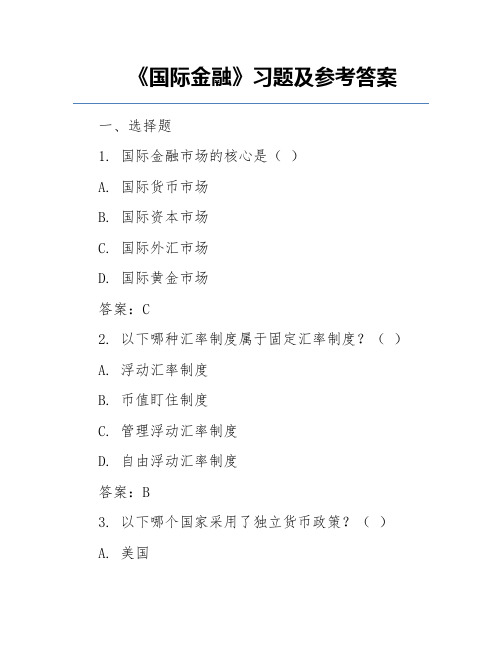
《国际金融》习题及参考答案一、选择题1. 国际金融市场的核心是()A. 国际货币市场B. 国际资本市场C. 国际外汇市场D. 国际黄金市场答案:C2. 以下哪种汇率制度属于固定汇率制度?()A. 浮动汇率制度B. 币值盯住制度C. 管理浮动汇率制度D. 自由浮动汇率制度答案:B3. 以下哪个国家采用了独立货币政策?()A. 美国B. 欧元区C. 日本D. 英国答案:A4. 国际收支平衡表中,经常账户包括以下哪项?()A. 货物贸易B. 服务贸易C. 收益D. 以上都对答案:D二、判断题1. 国际货币基金组织(IMF)的主要任务是促进国际货币合作和平衡国际收支。
()答案:正确2. 浮动汇率制度下,汇率完全由市场供求关系决定,不受政府干预。
()答案:错误3. 国际金融市场一体化有利于全球资源的优化配置,提高金融市场的效率。
()答案:正确4. 汇率上升,本币贬值,有利于出口,不利于进口。
()答案:正确三、简答题1. 简述国际金融市场的功能。
答:国际金融市场的功能主要包括以下几点:(1)资金融通功能:国际金融市场为全球各国政府、企业及金融机构提供资金筹集和投资渠道。
(2)风险转移功能:国际金融市场通过金融衍生品等工具,为参与者提供风险转移和避险手段。
(3)价格发现功能:国际金融市场为各类金融产品提供价格发现机制,有助于市场参与者做出合理的投资决策。
(4)促进国际贸易和投资:国际金融市场为国际贸易和投资提供金融支持,降低交易成本,提高交易效率。
2. 简述固定汇率制度和浮动汇率制度的优缺点。
答:固定汇率制度优点:(1)降低汇率波动风险,有利于国际贸易和投资。
(2)有利于国内经济政策的稳定。
缺点:(1)可能导致资源配置扭曲。
(2)容易产生货币危机。
浮动汇率制度优点:(1)自动调节国际收支。
(2)减少政府干预,提高市场效率。
缺点:(1)汇率波动可能导致国际贸易和投资风险增加。
(2)可能引发货币危机。
四、计算题1. 假设我国某年国际收支平衡表如下:经常账户:出口100亿美元,进口80亿美元;资本账户:净流出10亿美元。
《国际金融学》习题与答案

《国际金融学》习题答案《国际金融学》习题答案一、简答题1、国际收支平衡表的编制原理是什么?(1)记帐制度——复式簿记原理。
记账规则:有借必有贷,借贷必相等。
入表原则:凡是引起外汇流出的项目记入该项目的借方,凡是引起外汇流入的项目记入该项目的贷方。
(2)交易的记载时间。
IMF建议采用“权责发生制”,即所有权变更原则。
(3)记帐单位,国际收支平衡表一般按外币记载。
(4)定值(Valuation)在可以得到市场价格的情况下,按市场价格对交易定值债务工具大多按面值定值货物出口按离岸价格(FOB)定值来自海关的进口数据是到岸价格(CIF)数据,采用5%的调整系数,以得到离岸价格(FOB)数据。
2、国际收支平衡表的分析方法有哪些?(1)静态分析。
静态分析是对某一国一个时期的国际收支平衡表进行逐项,细致的分析。
包括:贸易差额;劳务差额;经常项目差额;基本差额;国际收支总差额。
(2)动态分析。
动态分析是对某国若干连续时期的国际收支平衡表进行分析。
动态分析实际上是对一国的国际收支进行纵向分析。
(3)比较分析。
比较分析是对不同国家同一时期的国际收支平衡表进行分析比较.将某一国某个时期的国际收支平衡表与其他国家进行对比,可以了解该国的国际经济地位和经济实力。
3、国际收支失衡的主要原因是什么?引起一国国际收支失衡的原因很多,概括起来主要有临时性因素、收入性因素、货币性因素、周期性因素和结构性因素。
(1)临时性失衡。
临时性失衡是指各国短期的、由非确定或偶然因素引起的国际收支失衡。
自然灾害、政局变化等意料之外的因素都可能对国际收支产生重大的影响。
(2)收入性失衡。
收入性失衡是指各国经济增长速度不同所引起的国际收支失衡。
一国国民收入相对快速增长,会导致进口需求的增长,从而使国际收支出现逆差。
(3)货币性失衡。
货币性失衡是指货币供应量的相对变动所引起的国际收支失衡。
一国货币供应量增长较快,会使该国出现较高的通货膨胀,在汇率变动滞后的情况下,国内货币成本上升,出口商品价格相对上升而进口价格相对下降,从而出现国际收支逆差。
国际金融习题与答案 (1)
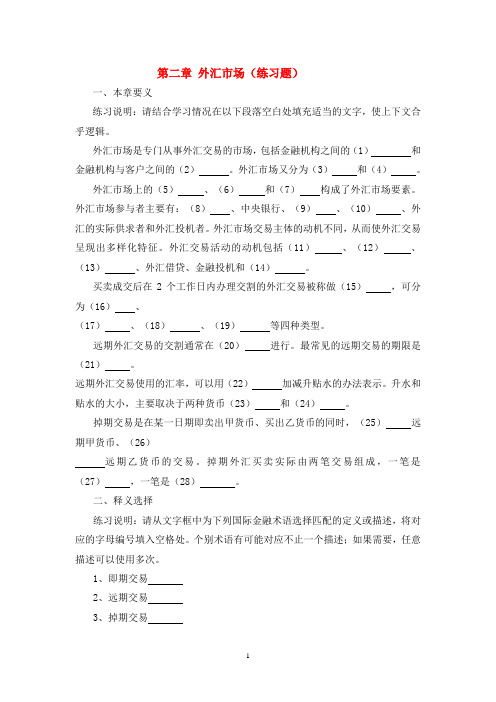
第二章外汇市场(练习题)一、本章要义练习说明:请结合学习情况在以下段落空白处填充适当的文字,使上下文合乎逻辑。
外汇市场是专门从事外汇交易的市场,包括金融机构之间的(1)和金融机构与客户之间的(2)。
外汇市场又分为(3)和(4)。
外汇市场上的(5)、(6)和(7)构成了外汇市场要素。
外汇市场参与者主要有:(8)、中央银行、(9)、(10)、外汇的实际供求者和外汇投机者。
外汇市场交易主体的动机不同,从而使外汇交易呈现出多样化特征。
外汇交易活动的动机包括(11)、(12)、(13)、外汇借贷、金融投机和(14)。
买卖成交后在2个工作日内办理交割的外汇交易被称做(15),可分为(16)、(17)、(18)、(19)等四种类型。
远期外汇交易的交割通常在(20)进行。
最常见的远期交易的期限是(21)。
远期外汇交易使用的汇率,可以用(22)加减升贴水的办法表示。
升水和贴水的大小,主要取决于两种货币(23)和(24)。
掉期交易是在某一日期即卖出甲货币、买出乙货币的同时,(25)远期甲货币、(26)远期乙货币的交易。
掉期外汇买卖实际由两笔交易组成,一笔是(27),一笔是(28)。
二、释义选择练习说明:请从文字框中为下列国际金融术语选择匹配的定义或描述,将对应的字母编号填入空格处。
个别术语有可能对应不止一个描述;如果需要,任意描述可以使用多次。
1、即期交易2、远期交易3、掉期交易4、汇入汇款5、汇出汇款6、进口付汇7、出口收汇8、单位元法9、单位镑法10、多头11、空头12、外汇交易商13、外汇经纪商14、无形市场15、外汇批发市场16、外汇零售市场17、升水18、贴水A、外汇银行在外汇最后总供给者与需求者之间发挥中介作用,一方面从顾客手中买入外汇,另一方面又将外汇卖给顾客,从中赚取买卖差价。
B、专门从事介绍成交或代客买卖外汇,从中收取手续费的公司或汇兑商,主要依靠与外汇银行的密切联系、熟知外汇供求情况的优势,接洽外汇交易,促使多种多样的市场参与者找到合适的交易价格和合适的交易对手成交。
国际金融习题参考答案
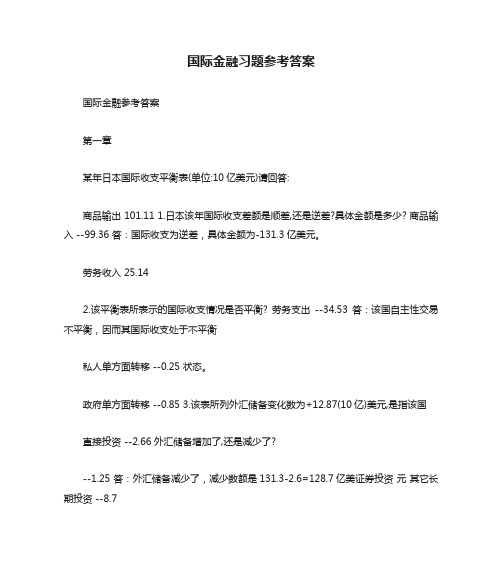
国际金融习题参考答案国际金融参考答案第一章某年日本国际收支平衡表(单位:10亿美元)请回答:商品输出 101.11 1.日本该年国际收支差额是顺差,还是逆差?具体金额是多少? 商品输入 --99.36 答:国际收支为逆差,具体金额为-131.3亿美元。
劳务收入 25.142.该平衡表所表示的国际收支情况是否平衡? 劳务支出--34.53 答:该国自主性交易不平衡,因而其国际收支处于不平衡私人单方面转移 --0.25 状态。
政府单方面转移 --0.85 3.该表所列外汇储备变化数为+12.87(10亿)美元,是指该国直接投资 --2.66 外汇储备增加了,还是减少了?--1.25 答:外汇储备减少了,减少数额是131.3-2.6=128.7亿美证券投资元其它长期投资 --8.7其它短期投资 5.84 4.该年的国际收支情况对日元汇率有何影响?答:单从国际收支角度看,该国货币有贬值趋势。
错误和遗漏 2.38对外国官方债务 0.26 第二章1.已知USD、HKD、RMB的基本汇率为:USD1=HKD7.7268 外汇储备变化+12.87 USD1=RMB8.3261 求港元与人民币的汇率?答:港元兑人民币的汇率为:HKD1=8.3261/7.7268= RMB 1.07762.某日电讯行市:GBP1=USD1.5541 USD1=Can1.1976 求英镑对加元的套算汇率为多少?答:因为GBP1=USD1.5541 USD1=Can1.1976所以,英镑兑加元的套算汇率为GPB1= 1.5541×1.1976=Can1.86123.已知在纽约外汇市场上三个月美元利率4%,瑞士法朗利率6%,即期汇率USD1=SF1.5,求三个月期美元远期汇率升(贴)水?答:因为三个月美元利率所以三个月美元远期汇率升水,升水点数=1.5×(6%-4%)×3/12=SF0.00754.已知在纽约外汇市场上美元六个月期利率10%,港元六个月期利率6%,即期汇率USD1= HKD7.7120,求港元六个月远期汇率?[升(贴)水=即期汇率x两国利差x期限]答:因为美元六个月期利率>港元六个月期利率(10%>6%)所以港元六个月远期汇率升水,升水点数=7.7120×(10%-6%)×6/12=HKD0.1542 因为在纽约外汇市场用间接标价法,所以港元六个月远期汇率为:USD1= 7.7120-0.1542=HKD7.55781第三章1、英国三个月期利率为9%,美国为6%,外汇市场汇率USD1=GBP0.6525,若美国投资者用1532567.25美元进行投资,在两地分别获得利息收入多少?假定到期汇率不变,可获净利多少美元?如果到期美元对英镑升值3.5%,汇率变动为USD1=GBP0.6753,将亏损多少美元? 答:美国投资者在美国获得的利息收入为:1532567.25×6%×3/12=22988.51美元在英国获得的利息收入为:1532567.25×0.6525×9%×3/12=22500.00英镑如果到期汇率不变,则可获净利为(1532567.25×0.6525×9%×3/12)/0.6525=33482.76美元如果汇率变动为USD1=GBP0.6753,则将亏损:(1532567.25+22988.51)―[1532567.25×0.6525×(1+9%×3/12)]/0.6753=4141 3.702、某日,在N.Y市场上USD1=FF5.1,在Paris市场上GBP1=FF8.51在London市场上GBP1=USD1.69,问可否套汇?现有1000万美元,如何套? 答:①统一标价N.Y市场和London市场都是间接标价法,所以只需转换Paris市场标价:FF1=GBP0.1175②将三个标价相乘的结果与1比较 5.1×1.69×0.1175=1.0127>1 所以可以套汇套汇途径:用1000万美元在N.Y市场可换得5100万法国法郎,然后在Paris市场可换得599.2949万英镑(5100×0.1175=599.295),最后在London市场可换得1012.7325万美元(599.25×1.69=1012.7325)3、设伦敦市场上的美元即期汇率为:GBP1=USD1.6125/30,美国和英国存款年利率分别为6%和10%,求一年期远期汇率?求美元升(贴)水额?答:因为美国存款年利率升水额=1.6125×(10%―6%)~1.6130×(10%―6%)=USD0.06450/0.06452 因为在伦敦市场是间接标价法,所以美元一年期远期汇率为:GBP=1.6125―0.06450/1.6130―0.06452=USD1.54800/1.54848练习题1、港某商行于1999年9月17日拟向印度出口一批印刷机,原以港元向其报价,每台单价为90000港元,印商要该商行改用美元向其报价。
国际金融作业(答案)
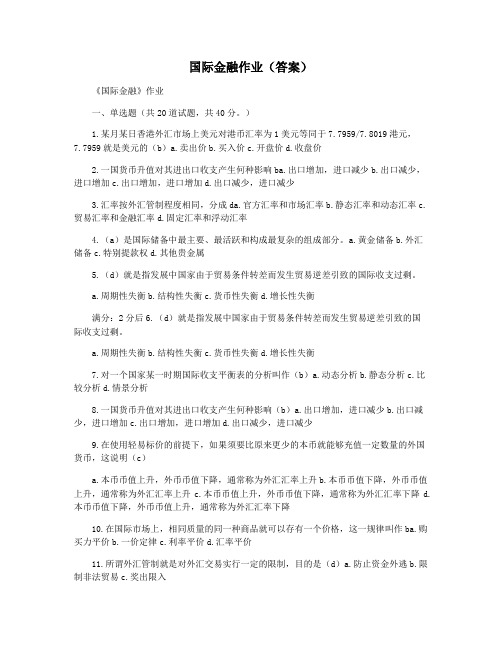
国际金融作业(答案)《国际金融》作业一、单选题(共20道试题,共40分。
)1.某月某日香港外汇市场上美元对港币汇率为1美元等同于7.7959/7.8019港元,7.7959就是美元的(b)a.卖出价b.买入价c.开盘价d.收盘价2.一国货币升值对其进出口收支产生何种影响ba.出口增加,进口减少b.出口减少,进口增加c.出口增加,进口增加d.出口减少,进口减少3.汇率按外汇管制程度相同,分成da.官方汇率和市场汇率b.静态汇率和动态汇率c.贸易汇率和金融汇率d.固定汇率和浮动汇率4.(a)是国际储备中最主要、最活跃和构成最复杂的组成部分。
a.黄金储备b.外汇储备c.特别提款权d.其他贵金属5.(d)就是指发展中国家由于贸易条件转差而发生贸易逆差引致的国际收支过剩。
a.周期性失衡b.结构性失衡c.货币性失衡d.增长性失衡满分:2分后6.(d)就是指发展中国家由于贸易条件转差而发生贸易逆差引致的国际收支过剩。
a.周期性失衡b.结构性失衡c.货币性失衡d.增长性失衡7.对一个国家某一时期国际收支平衡表的分析叫作(b)a.动态分析b.静态分析c.比较分析d.情景分析8.一国货币升值对其进出口收支产生何种影响(b)a.出口增加,进口减少b.出口减少,进口增加c.出口增加,进口增加d.出口减少,进口减少9.在使用轻易标价的前提下,如果须要比原来更少的本币就能够充值一定数量的外国货币,这说明(c)a.本币币值上升,外币币值下降,通常称为外汇汇率上升b.本币币值下降,外币币值上升,通常称为外汇汇率上升c.本币币值上升,外币币值下降,通常称为外汇汇率下降d.本币币值下降,外币币值上升,通常称为外汇汇率下降10.在国际市场上,相同质量的同一种商品就可以存有一个价格,这一规律叫作ba.购买力平价b.一价定律c.利率平价d.汇率平价11.所谓外汇管制就是对外汇交易实行一定的限制,目的是(d)a.防止资金外逃b.限制非法贸易c.奖出限入d.均衡国际收支、管制汇价12.汇率按外汇管制程度不同,分为(a)a.官方汇率和市场汇率b.静态汇率和动态汇率c.贸易汇率和金融汇率d.固定汇率和浮动汇率13.1990年8月伊拉克强占科威特,引发世界各国对伊拉克的全面经济制裁,伊拉克因石油出口中断,外汇收入锐减,国际收支轻微转差。
15春北航《国际金融》在线作业一满分答案

奥鹏15春北航《国际金融》在线作业一
一、单选题(共25 道试题,共75 分。
)
1. 欧洲货币市场是( )
A. 经营欧洲货币单位的国家金融市场
B. 经营欧洲国家货币的国际金融市场
C. 欧洲国家国际金融市场的总称
D. 经营境外货币的国际金融市场
正确答案:C
2. 汇率不稳有下浮趋势且在外汇市场上被人们抛售的货币是()
A. 非自由兑换货币
B. 硬货币
C. 软货币
D. 自由外汇
正确答案:C
3. 货币市场利率的变化影响证券价格的变化,如果市场利率上升超过未到期公司债券利率,则()
A. 债券价格上涨,股票价格上涨
B. 债券价格下跌,股票价格下跌
C. 债券价格上涨,股票价格下跌
D. 债券价格下跌,股票价格上涨
正确答案:B
4. 史密森协定规定市场外汇汇率波动幅度从±1%扩大到( )
A. ±2.25%
B. ±6%
C. ±10%
D. 自由浮动
正确答案:A
5. 如果一种货币的远期汇率低于即期汇率,称之为( )
A. 升水
B. 贴水
C. 隔水
D. 平水
正确答案:B
6. 发行特别提款权的时间是()。
A. 1970年
B. 1968年
C. 1969年。
(完整版)第一章国际金融练习与答案

5.如果你以电话向中国银行询问英镑/美元(英镑兑美元,斜线“/”表示“兑”)的汇价。
中国银行答道:。
请问:(1)中国银行以什么汇价向你买进美元?(2)你以什么汇价从中国银行买进英镑?(3)如果你向中国银行卖出英镑,汇率是多少?5、解:银行买入1英镑,支付客户(卖出)1.6900美元③银行卖出1英镑,收取客户(买入)1.6910美元①②6.某银行询问美元兑新加坡元的汇价,你答复道:“1美元。
请问:如果该银行想把美元卖给你,汇率是多少?6、解:你(卖方)买入1美元,支付银行1.6403S$★银行卖出1美元,收取银行1.6403S$★你(卖方)卖出1美元,收取银行1.6410S$银行买入1美元,支付客户1.6410S$7.某银行询问美元兑港元汇价,你答复道:“1美元港元”,请问:(1)该银行要向你买进美元,汇价是多少?(2)如你要买进美元,应按什么汇率计算?(3)如你要买进港元,又是什么汇率?7、解:你(卖方)买入1美元,支付银行7.8000HKD②银行卖出1美元,收取客户7.8000HKD你(卖方)卖出1美元,收取银行7.8010HKD③银行买入1美元,支付客户7.8010HKD①8、如果你是ABC银行的交易员,客户向你询问澳元/美元汇价,你答复道:。
请问:(1)如果客户想把澳元卖给你,汇率是多少?(2)如果客户要买进澳元,汇率又是多少?8、解:银行买入1澳元,支付客户0.7685美元(客户卖出1澳元,收取客户0.7685美元)①银行卖出1澳元,收取客户0.7690美元(客户买入1澳元,支付客户0.7690美元)②9、如果你向中国银行询问美元/欧元的报价,回答是:。
请问:(1)中国银行以什么汇价向你买入美元,卖出欧元?(2)如果你要买进美元,中国银行给你什么汇率?(3)如果你要买进欧元,汇率又是多少?9、解:银行买入1美元,支付客户1.2940∈①(客户卖出1美元,收取客户1.2940∈)③银行卖出1美元,收取客户1.2960∈(客户买入1美元,支付银行1.2960∈)②10、如果你是银行,客户向你询问美元兑瑞士法郎汇价,你答复道:。
《国际金融 I》题库及答案
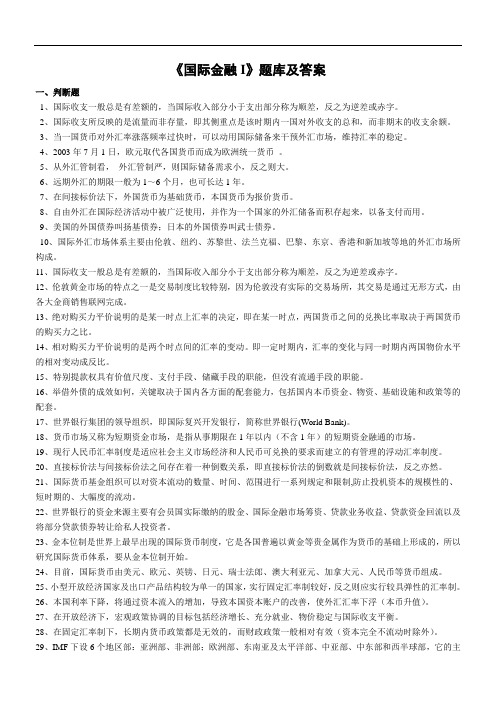
《国际金融I》题库及答案一、判断题1、国际收支一般总是有差额的,当国际收入部分小于支出部分称为顺差,反之为逆差或赤字。
2、国际收支所反映的是流量而非存量,即其侧重点是该时期内一国对外收支的总和,而非期末的收支余额。
3、当一国货币对外汇率涨落频率过快时,可以动用国际储备来干预外汇市场,维持汇率的稳定。
4、2003年7月1日,欧元取代各国货币而成为欧洲统一货币。
5、从外汇管制看,外汇管制严,则国际储备需求小,反之则大。
6、远期外汇的期限一般为1~6个月,也可长达1年。
7、在间接标价法下,外国货币为基础货币,本国货币为报价货币。
8、自由外汇在国际经济活动中被广泛使用,并作为一个国家的外汇储备而积存起来,以备支付而用。
9、美国的外国债券叫扬基债券;日本的外国债券叫武士债券。
10、国际外汇市场体系主要由伦敦、纽约、苏黎世、法兰克福、巴黎、东京、香港和新加坡等地的外汇市场所构成。
11、国际收支一般总是有差额的,当国际收入部分小于支出部分称为顺差,反之为逆差或赤字。
12、伦敦黄金市场的特点之一是交易制度比较特别,因为伦敦没有实际的交易场所,其交易是通过无形方式,由各大金商销售联网完成。
13、绝对购买力平价说明的是某一时点上汇率的决定,即在某一时点,两国货币之间的兑换比率取决于两国货币的购买力之比。
14、相对购买力平价说明的是两个时点间的汇率的变动。
即一定时期内,汇率的变化与同一时期内两国物价水平的相对变动成反比。
15、特别提款权具有价值尺度、支付手段、储藏手段的职能,但没有流通手段的职能。
16、举借外债的成效如何,关键取决于国内各方面的配套能力,包括国内本币资金、物资、基础设施和政策等的配套。
17、世界银行集团的领导组织,即国际复兴开发银行,简称世界银行(World Bank)。
18、货币市场又称为短期资金市场,是指从事期限在1年以内(不含1年)的短期资金融通的市场。
19、现行人民币汇率制度是适应社会主义市场经济和人民币可兑换的要求而建立的有管理的浮动汇率制度。
2019超星尔雅《国际金融》课后作业答案

解析:
14.印尼发生海啸, 中国政府无偿向其政府提供40万美元的救灾物资, 则下列说法正确的是
A. 该救灾物资属于货物出口, 应记入经常账户-货物与服务账户-货物出口账户下的贷方
B. 这种行为属于国际援助, 应记入经常账户-经常转移-政府间转移账户下的贷方
C. 救灾物资属于国际援助, 与货物出口无关
D. 允许非居民使用非生产非金融资产, 会产生租金收入
正确答案: D
解析:
2.以下哪类资产不属于外汇储备?
A. 外币现钞
B. 特别提款权
C. 央行在国外的外币存款
D. 货币性黄金
正确答案: A
解析:
3.在货币分析法框架下, 下列说法正确的是
A、 将货币供应量分为两个部分, 一部分来源于央行信贷, 另一部分来源于外汇储备。
B. 国际投资头寸包括一国居民对非居民的股权、债权以及货币黄金等金融资产, 以及国居民对于非居民的金融负债
C. 国际投资净头寸就是对外金融资产存量减去对外金融负债存量的差额。若差额为正, 该国为净债权国(net creditor);反之, 差额为负, 该国为净债务国(net debtor)。
D. 如果本国经常账户和资本账户差额的合计为正, 表示本国让渡了实际资源, 反之, 表示本国占用了其他国家的实际资源。
B. 探析了各国经济通过进出口途径相互影响的机制
C. 其分析考虑了国际间的资本流动
D. 理论建立在凯恩斯乘数原理下
正确答案: C
解析:
6.关于连乘法, 下列说法中错误的是
A. 连乘法初始货币和结束货币必须不同
B. 使用连乘法时, 要注意各个货币的买入价和卖出价
C. 买入某种货币时, 应选择较大的报价
国际金融作业1-答案武汉大学余静文

国家 (货币) 加拿大(加元) 墨西哥(比索)
贸易份额(%) 2002 年 36 28 0.641 0.098 0.121 0.008
2003 年 0.763 0.089 0.121 0.009
美元/外币 美元/外币
中国(人民币元) 20 16 日本(日元)
a. 根据表中数据,计算 2002 年到 2003 年,加、墨、中、日四国货币对美元的双 边汇率变化率(以每单位外币折合若干美元表示)。 b. 用贸易份额作为权重,计算 2002 年至 2003 年美元的名义有效汇率变化的百分 比。 c. 在(b)题的基础上,2002 年至 2003 年美元兑这一篮子货币的价值发生了什 么变化?与同一时期美元兑墨西哥比索的价值变化进行比较,上述变化有什么 不同?
g.1.5*(1+2.04%)
4. 略
d.假设即期汇率为 1.5 欧元/英镑,利率如题所述,依据抛补利率平价,均衡的远期 汇率是多少? e.假设远期汇率采用(d)题中计算的值,计算英镑对于荷兰投资者的远期升水率 (汇率变化率)。 f.如果无抛补利率平价成立,欧元兑英镑一年的预期贬值率(汇率变化率)是多 少? g.在回答(f)题的基础上,1 年期的预期欧元-英镑汇率是多少?
4.你是一家美国公司的金融顾问,该公司出口一批货物到日本,预计 180 天后将收 到贷款 4000 万日元,现在日元兑美元的汇率为 1 美元=100 日元,你担心未来 6 个月内美元兑日元会升值: a.假定日元兑美元的汇率保持不变,你们公司预计会收到多少美元? b.如果美元升值到 1 美元=110 日元,你们公司会收到多少货款(以美元计)? c.请阐述你将如何利用期权合约来对冲美元潜在升值带来的风险。
答案 1. 略。
2. 略。
(完整版)国际金融习题含答案

(完整版)国际金融习题含答案一、填空题1. 国际金融市场中,外汇市场的交易额远远超过其他金融市场,每天的交易额约为______万亿美元。
答案:6.62. 根据汇率变动的弹性,汇率制度可以分为固定汇率制度和______。
答案:浮动汇率制度3. 国际货币基金组织(IMF)成立于______年,总部设在美国首都华盛顿。
答案:19444. 国际金融市场上,美元指数(USDX)是衡量美元对一篮子货币汇率变动的指标,目前美元指数的权重货币包括美元、欧元、日元、英镑和______。
答案:瑞士法郎二、选择题1. 以下哪项不是国际收支平衡表的组成部分?A. 经常账户B. 资本账户C. 错误和遗漏账户D. 通货膨胀账户答案:D2. 以下哪种汇率制度属于固定汇率制度?A. 金本位制B. 物价挂钩制C. 管理浮动汇率制度D. 自由浮动汇率制度答案:A3. 以下哪个国家不属于世界四大经济体?A. 美国B. 中国C. 德国D. 日本答案:D4. 以下哪个国家是世界上最大的外汇储备国?A. 美国B. 中国C. 日本D. 德国答案:B三、判断题1. 国际金融市场的形成和发展,有利于全球资源的优化配置和风险分散。
()答案:正确2. 浮动汇率制度下,汇率完全由市场供求关系决定,政府不进行任何干预。
()答案:错误3. 国际货币基金组织(IMF)的主要任务是调整国际收支失衡,促进成员国经济的稳定增长。
()答案:正确4. 通货膨胀率高的国家,其货币汇率往往呈贬值趋势。
()答案:正确四、简答题1. 简述国际金融市场的功能。
答案:国际金融市场的功能主要包括以下几点:(1)资金融通功能:为全球范围内的资金需求者和资金供应者提供融资和投资渠道;(2)风险分散功能:通过金融工具的多样化,降低投资者面临的风险;(3)价格发现功能:金融市场上的价格反映了市场供求关系,有助于投资者做出投资决策;(4)促进国际贸易和投资的发展:国际金融市场为国际贸易和投资提供了便利条件。
国际金融作业习题及习题答案教学教材

国际金融作业习题及习题答案习题答案1、某日纽约 USD1=HKD7、7820—7、7830伦敦 GBP1= USD1、5140---1、5150问英镑与港元的汇率是多少?解:GBP1=HKD7.7820 X 1.5140-----7.7830 X 1.5150 GBP1=HKD11.7819-----11.79122、某日苏黎士 USD1= SF1、2280----1、2290法兰克福 USD1= E0、9150----0、9160问法兰克福市场欧元与瑞士法郎的汇率是多少?解:E1=SF1.2280/0.9160------SF1.2290/0.9150E1=SF1.3406------1.34323、某日 GBP1=HKD12、6560----12、6570USD1=HKD 7、7800---- 7、7810问英镑与美元的汇率是多少?解:GBP1=USD12.6560/7.7810--------12.6570/7.7800GBP1=USD1.6265--------1.62694、某日巴黎即期汇率 USD1=E0、8910----0、89201个月远期 20-----------30问巴黎市场美元与欧元1个月远期汇率是多少?解:一个月远期 USD1=E0.8930-------0.89505、某日香港即期汇率 USD1=HKD7、7800---7、7810 3个月远期 70-----------50问香港市场美元与港元3个月远期汇率是多少?解:三人月远期 USD1=HKD7.7730---------7.77606、某日纽约即期汇率 USD1=SF1、1550----1、15606个月远期 60------------80问纽约市场美元与瑞士法郎6个月远期汇率是多少?解:六个月远期 USD1=SF1.1610-------1.16407、某日伦敦即期汇率 GBP1=E 1、2010-----1、20203个月远期 40-------------50问伦敦市场英镑与欧元3个月远期汇率是多少?解:三个月远期 GBP1=E1.2050---------1.20708、某企业出口铝材,人民币报价为15000元/吨,现改用美元报价,其价格应为多少?(即期汇率USD1=RMB6、8310—6、8380)解:15000÷6.8310=2196美元9、某企业进口商品人民币报价为11000元/件,现改用美元报价,应为多少?(汇率同上)解:11000÷6.8380=1609美元10、某企业出口商品美元报价为2500美元/件,现改用人民币报价,应为多少?(汇率同上)解:2500 X 6.8380=17095元11、某企业进口商品报价为5700美元/吨,现改用人民币报价,应为多少?(汇率同上)解:5700 X 6.8310=38937元12、某出口商品的报价为SF8500/件,现改用美元报价,应为多少?(即期汇率USD1=SF1、1830—1、1840)解:8500÷1.1830=7185美元13、某进口商品的报价为SF21500/吨,现改用美元报价,应为多少?(汇率同上)解:21500÷1.1840=18159美元14.某日:即期汇率USD1=EUR0.9150 — 0.9160? 3个月 40 ------ 60某出口商3个月后将收入1000万美元,届时需兑换成欧元,问该出口商应如何通过远期交易进行套期保值?解:3个月远期 USD1=EUR0.9190------0.9220签3个月远期合约卖出1000万美元,买入919万欧元.15、某日:即期汇率 USD1=SF1.3210 —1.3220? 6个月 80 -----60该进口商6个月后将向出口商支付1000万美元,届时需用瑞士法郎兑换,问该进口商将如何利用远期外汇交易进行套期保值?解:6个月远期 USD1=SF1.3130-------1.3160签6个月远期合约卖出瑞士法郎1316万,买入1000万美元。
《国际金融》的习题及答案
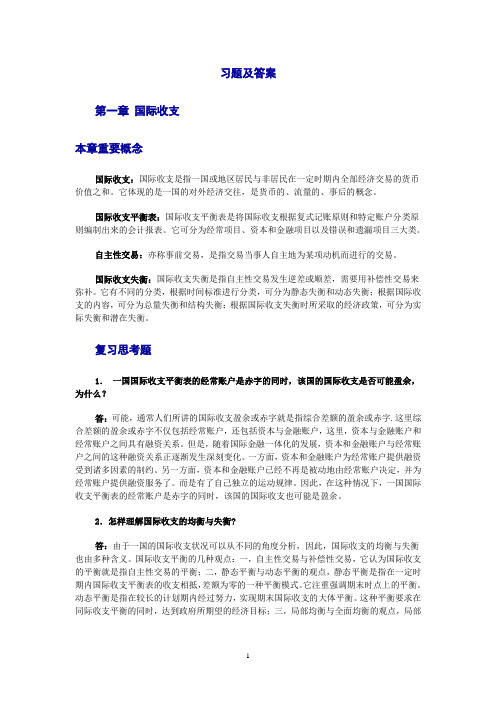
习题及答案第一章国际收支本章重要概念国际收支:国际收支是指一国或地区居民与非居民在一定时期内全部经济交易的货币价值之和。
它体现的是一国的对外经济交往,是货币的、流量的、事后的概念。
国际收支平衡表:国际收支平衡表是将国际收支根据复式记账原则和特定账户分类原则编制出来的会计报表。
它可分为经常项目、资本和金融项目以及错误和遗漏项目三大类。
自主性交易:亦称事前交易,是指交易当事人自主地为某项动机而进行的交易。
国际收支失衡:国际收支失衡是指自主性交易发生逆差或顺差,需要用补偿性交易来弥补。
它有不同的分类,根据时间标准进行分类,可分为静态失衡和动态失衡;根据国际收支的内容,可分为总量失衡和结构失衡;根据国际收支失衡时所采取的经济政策,可分为实际失衡和潜在失衡。
复习思考题1.一国国际收支平衡表的经常账户是赤字的同时,该国的国际收支是否可能盈余,为什么?答:可能,通常人们所讲的国际收支盈余或赤字就是指综合差额的盈余或赤字.这里综合差额的盈余或赤字不仅包括经常账户,还包括资本与金融账户,这里,资本与金融账户和经常账户之间具有融资关系。
但是,随着国际金融一体化的发展,资本和金融账户与经常账户之间的这种融资关系正逐渐发生深刻变化。
一方面,资本和金融账户为经常账户提供融资受到诸多因素的制约。
另一方面,资本和金融账户已经不再是被动地由经常账户决定,并为经常账户提供融资服务了。
而是有了自己独立的运动规律。
因此,在这种情况下,一国国际收支平衡表的经常账户是赤字的同时,该国的国际收支也可能是盈余。
2.怎样理解国际收支的均衡与失衡?答:由于一国的国际收支状况可以从不同的角度分析,因此,国际收支的均衡与失衡也由多种含义。
国际收支平衡的几种观点:一,自主性交易与补偿性交易,它认为国际收支的平衡就是指自主性交易的平衡;二,静态平衡与动态平衡的观点,静态平衡是指在一定时期内国际收支平衡表的收支相抵,差额为零的一种平衡模式。
它注重强调期末时点上的平衡。
《国际金融》试题及答案

《国际金融》试题及答案一、选择题(每题2分,共20分)1. 以下哪项不是国际金融市场的主要功能?A. 资金融通B. 外汇交易C. 保险服务D. 商品交易答案:D2. 以下哪个国家不属于国际货币基金组织的创始成员国?A. 美国B. 英国C. 法国D. 中国答案:D3. 以下哪个组织不属于国际金融监管机构?A. 国际货币基金组织B. 世界银行C. 国际证监会组织D. 国际清算银行答案:B4. 以下哪个因素不会影响国际金融市场的汇率?A. 国际收支状况B. 货币政策C. 贸易政策D. 气候变化答案:D5. 以下哪个国家的货币被认为是国际储备货币?A. 英国B. 德国C. 法国D. 美国答案:D6. 以下哪个金融市场不属于国际金融市场?A. 欧洲金融市场B. 亚洲金融市场C. 美国金融市场D. 非洲金融市场答案:D7. 以下哪个汇率制度不属于固定汇率制度?A. 金本位制B. 布雷顿森林体系C. 浮动汇率制度D. 物价挂钩制度答案:C8. 以下哪个国家没有采用浮动汇率制度?A. 美国B. 英国C. 德国D. 法国答案:C9. 以下哪个因素不会影响国际金融市场的资本流动?A. 利率差异B. 汇率波动C. 政策因素D. 贸易壁垒答案:D10. 以下哪个国家不属于国际金融市场的三大金融中心?A. 纽约B. 伦敦C. 香港D. 东京答案:D二、简答题(每题10分,共40分)1. 简述国际金融市场的基本功能。
答案:国际金融市场的基本功能包括:(1)资金融通:为各国政府、企业和个人提供融资和投资渠道。
(2)外汇交易:实现不同货币之间的兑换,满足国际贸易和投资需求。
(3)风险管理:为参与者提供避险工具,降低汇率、利率等风险。
(4)信息传递:为金融市场参与者提供全球金融市场信息和数据。
2. 简述国际货币基金组织的主要任务。
答案:国际货币基金组织的主要任务包括:(1)促进国际货币合作,为成员国提供政策建议和协调。
(2)促进国际贸易平衡发展,稳定汇率。
(完整版)国际金融习题含答案..
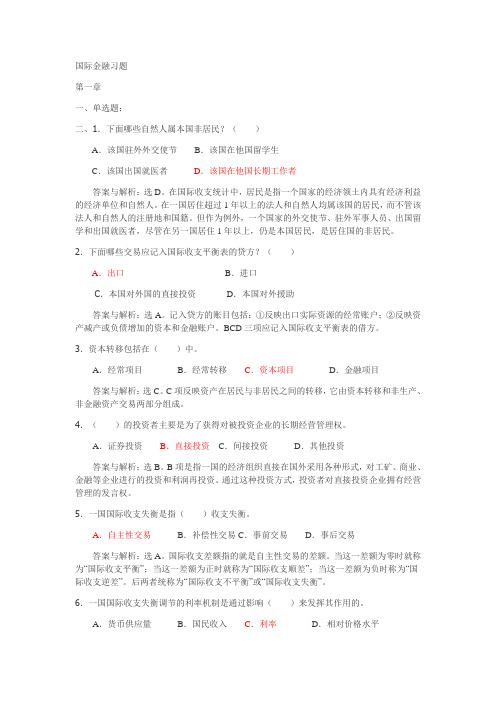
国际金融习题第一章一、单选题:二、1.下面哪些自然人属本国非居民?()A.该国驻外外交使节B.该国在他国留学生C.该国出国就医者D.该国在他国长期工作者答案与解析:选D。
在国际收支统计中,居民是指一个国家的经济领土内具有经济利益的经济单位和自然人。
在一国居住超过1年以上的法人和自然人均属该国的居民,而不管该法人和自然人的注册地和国籍。
但作为例外,一个国家的外交使节、驻外军事人员、出国留学和出国就医者,尽管在另一国居住1年以上,仍是本国居民,是居住国的非居民。
2.下面哪些交易应记入国际收支平衡表的贷方?()A.出口B.进口C.本国对外国的直接投资D.本国对外援助答案与解析:选A。
记入贷方的账目包括:①反映出口实际资源的经常账户;②反映资产减产或负债增加的资本和金融账户。
BCD三项应记入国际收支平衡表的借方。
3.资本转移包括在()中。
A.经常项目B.经常转移C.资本项目D.金融项目答案与解析:选C。
C项反映资产在居民与非居民之间的转移,它由资本转移和非生产、非金融资产交易两部分组成。
4.()的投资者主要是为了获得对被投资企业的长期经营管理权。
A.证券投资B.直接投资C.间接投资D.其他投资答案与解析:选B。
B项是指一国的经济组织直接在国外采用各种形式,对工矿、商业、金融等企业进行的投资和利润再投资。
通过这种投资方式,投资者对直接投资企业拥有经营管理的发言权。
5.一国国际收支失衡是指()收支失衡。
A.自主性交易B.补偿性交易C.事前交易D.事后交易答案与解析:选A。
国际收支差额指的就是自主性交易的差额。
当这一差额为零时就称为“国际收支平衡”;当这一差额为正时就称为“国际收支顺差”;当这一差额为负时称为“国际收支逆差”。
后两者统称为“国际收支不平衡”或“国际收支失衡”。
6.一国国际收支失衡调节的利率机制是通过影响()来发挥其作用的。
A.货币供应量B.国民收入C.利率D.相对价格水平答案与解析:选C。
利率机制是指一国国际收支不平衡时,该国的利率水平会发生变动,利率水平的变动反过来又会对国际收支不平衡起到一定的调节作用。
- 1、下载文档前请自行甄别文档内容的完整性,平台不提供额外的编辑、内容补充、找答案等附加服务。
- 2、"仅部分预览"的文档,不可在线预览部分如存在完整性等问题,可反馈申请退款(可完整预览的文档不适用该条件!)。
- 3、如文档侵犯您的权益,请联系客服反馈,我们会尽快为您处理(人工客服工作时间:9:00-18:30)。
《国际金融I》作业答案一、判断题1、(×)2、(√)3、(×)4、(×)5、(√)6、(√)7、(×)8、(√)9、(√)10、(√)11、(×)12、(√)13、(√)14、(×)15、(√)16、(√)17、(√)18、(×)19、(√)20、(√)21、(√)22、(√)23、(√)24、(×)25、(√)26、(×)27、(√)28、(√)29、(×)30、(√)31、(√)32、(√)二、名词解释1、国际收支:一国居民在一定时期内与外国居民所进行的全部经济交易的系统的货币记录。
2、马歇尔—勒纳条件:一国货币贬值后,会引起进出口商品价格变动,进而引起进出口商品的数量发生变动,最终引起贸易收支变动。
3、国际收支平衡表:系统记录一国在一定时期内(通常为一年)各种国际收支项目及其金额的一种会计报表。
它由经常账户、资本与金融账户组成。
4、经常转移:居民与非居民之间的实际资源或金融产品的所有权发生了变更,不管变化是自愿的还是非自愿的,这种所有权的变更没有涉及经济价值回报,而转移正是这类变更的平衡项目。
5、特别提款权:一种依靠国际纪律创造出来储备资产,是基金组织按会员国缴纳基金的份额分配给会员国的一种使用资金的权利。
6、汇率:又称外汇牌价、汇价、货币的兑换率、外汇行市等。
简单地理解为一种价格,是货币之间的互换比率7、新兴国际金融市场:是相对于传统金融市场而言的,是指主要为非居民提供境外货币借贷等金融业务的国际金融市场,所以又称为境外市场或离岸金融市场。
8、国际货币体系:国际间金融往来引起的资金流动运行规律及其组织规则的有机体,它集中反映了国际货币体系的发展、汇率制度的建立以及国际收支的调节问题。
9、外汇管制:是一国政府利用各种法令、规定和措施,对居民和非居民外汇买卖的数量和价格加以严格的行政控制,以平衡国际收支,维持汇率,以及集中外汇资金,根据政策需要加以分配。
10、国际储备管理:一国货币当局对国际储备的规模、结构和储备资产的运用等进行调整和控制,以达到储备资产规模的适度化、结构的最优化和效益的最大化,并实现调控国民经济和国际收支的目标。
11、汇率制度:又称汇率安排,是指一国货币当局对本国汇率水平的确定。
12、套汇:是利用各国外汇市场上某种货币汇率或者利率的差异,在两个或者多个外汇市场上同时构筑货币头寸赚取无风险利润。
13、国际直接投资(FDI):一国居民取得在其它国家经济活动的管理控制权的投资14、国际储备:一国货币当局所持有的﹑用于国际支付、平衡国际收支和维持汇率稳定的各种形式的国际储备资产。
15、浮动汇率:各国货币之间不规定固定比例,汇率波动不受限制,主要随外汇市场供求状况变动而波动的汇率。
16、国际金融市场:在国际之间进行资金融通的场所,是居民与非居民之间,或者非居民与非居民之间利用现代化通讯设备进行国际性金融业务活动的场所。
三、简答题1、编制国际收支表的用途是什么?(1)进行国际收支平衡状况分析国际收支平衡状况分析,重点是分析国际收支差额,并找出原因,以便采取相应对策,扭转不平衡状况。
(2)进行国际收支结构分析,可以揭示各个项目在国际收支中的地位和作用,从结构变化中发现问题找出原因,为指导对外经济活动提供依据。
2、经济交易指什么,包括哪些?当一个经济体向另一个经济体转移实物资产或金融资产的所有权或提供劳务时,便发生了经济交易。
它包括四类:(1)交换交换是指一经济体向另一经济体提供一宗经济价值并从对方得到相等价值的回报。
(2)转移转移即一经济体向另一经济体提供经济价值但并不得到回报。
转移包括:①商品和劳务的转移;②金融资产的转移。
(3)移居移居是指居民将住所从一经济体搬至另一经济体的行为。
由此造成资产、负债关系在两个经济体之间的变化。
而这一变化必须反映在国际收支中。
(4)其他根据推论而存在的交易根据推论而存在的交易是指尽管未发生实际的资本流动,但根据推论确定交易存在。
例如,投资收益的再投资等。
3.外汇必须具备的基本特征是什么?(1)外汇是以外币计值(或表示)的、可用作对外支付的金融资产。
(2)外汇具有可自由兑换性。
自由兑换性是指可以为任何目的、在任何情况下不受任何限制地将这种外币兑换成其他国家的货币或购买其他信用工具。
4、欧洲债券有哪些特点?(1)债券发行较为自由灵活,既不需要向任何监督机关登记注册,又无利率管制和发行数额限制,还可以选择多种计值货币。
(2)发行欧洲债券筹集的资金数额大、期限长,而且对财务公开的要求不高,方便筹资者筹集资金。
(3)欧洲债券通常由几家大的跨国金融机构办理发行,发行面广,手续简便,发行费用较低。
(4)欧洲债券的利息收入通常免交所得税。
(5)欧洲债券以不记名方式发行,并可以保存在国外,适合一些希望保密的投资者需要。
(6)欧洲债券安全性和收益率高。
欧洲债券发行者多为大公司、各国政府和国际组织,它们一般都有很高的信誉,对投资者来说是比较可靠的。
同时,欧洲债券的收益率也较高。
5、经济交易指什么,包括哪些?当一个经济体向另一个经济体转移实物资产或金融资产的所有权或提供劳务时,便发生了经济交易。
它包括四类:(1)交换交换是指一经济体向另一经济体提供一宗经济价值并从对方得到相等价值的回报。
(2)转移转移即一经济体向另一经济体提供经济价值但并不得到回报。
转移包括:①商品和劳务的转移;②金融资产的转移。
(3)移居移居是指居民将住所从一经济体搬至另一经济体的行为。
由此造成资产、负债关系在两个经济体之间的变化。
而这一变化必须反映在国际收支中。
(4)其他根据推论而存在的交易根据推论而存在的交易是指尽管未发生实际的资本流动,但根据推论确定交易存在。
例如,投资收益的再投资等。
6、简述国内货币体系和国际货币体系的区别。
(1)从货币体系形成的方式来看,国内货币制度是以国家法令强制确定的一国货币体系的组织形式;而国际货币体系是在国际经济和金融的长期实践中逐步形成的惯例和规则。
(2)从货币本位的确定来看,国内货币体系本位货币的规定,是具有绝对的垄断地位;而国际货币体系在内容和形式上都无十分严格的界定,具有一定的松散性和灵活性特征。
(3)从货币体系的法律属性上看,国内货币体系必须无条件充分执行;而国际货币体系中的规则和措施对各国只有一定的约束力而不具备法律的强制性。
7、牙买加体系的弊端有哪些?(1)汇率体系极不稳定。
在牙买加体系中,全球1/3的国家实行独立浮动或管理浮动汇率制,其余2/3的国家实行钉住汇率制,作为主要储备货币美元、日元、德国马克、英镑和法国法郎,只要这五种货币稳定,SDRs和ECU 也就稳定了。
由于英镑、法郎较弱,因此,整个货币体系的稳定实际上决定于美元、日元和德国马克之间的汇兑关系,而这三大货币波动巨大,使整个体系失去了稳定的基础。
(2)大国侵害小国利益,南北冲突更加尖锐。
由于主要工业国家基本上实行浮动汇率制,而大多数发展中国家采用钉住汇率制,大国往往只顾自身利益而独立行事或联合起来改变汇率,使钉住它们货币的发展中国家无论其经济状况好坏都不得不随之重新安排汇率,承受额外的外汇风险。
(3)国际收支调节机制不健全。
四大调节渠道都有局限性,都不是根本解决问题的办法。
亚洲金融危机和1999年美国贸易收支逆差持续扩大表明,牙买加体系创建20年来,全球范围的长期国际收支不平衡并未得以根除。
8、外汇市场的含义是什么?(1)外汇市场是国际金融市场的重要组成部分,与国际金融市场的其它构成部分(国际货币市场、国际资本市场)有着密切的联系。
(2)外汇市场是进行外汇买卖的场所。
(3)外汇市场的场所可以是有形的市场,也可以是无形的市场。
四、论述题1、论述国际收支失衡的原因,并加以解释答:(1)经济周期波动当一国经济处于衰退期时,社会总需求下降,进口需求也相应下降,国际收支发生盈余。
反之,如果一国经济处于扩张和繁荣时期,国内投资与消费需求旺盛,对进口的需求也相应增加,国际收支便出现逆差。
(2)国民收入变化一国的国民收入增加,商品、劳务的进口增加,从而引起国际收支恶化。
反之,一国的国民收入减少,购买力下降,引起物价下跌,有利于本国商品出口,并使进口减少,就会逐步缩小逆差,使国际收支达到平衡状态,甚至出现顺差。
(3)货币价值变动的影响一国货币供应量过分增加,引起国内物价上升,使其商品成本与物价水平相对地高于其他国家,该国商品出口必然受到抑制,而进口却受到鼓励,使国际收支发生逆差。
相反,则国际收支出现顺差。
(4)国际经济结构变化的影响一国的国际贸易在一定的生产条件和消费需求下处于均衡状态,当国际市场发生变化,该国不能及时调整本国的生产结构,原有的平衡被打破,贸易逆差出现。
或者该国的产业结构单一,生产的产品出口需求的收入弹性低、或出口需求的价格弹性高而进口需求价格弹性低所引起的国际收支失衡。
(5)除了以上所述原因外,还有季节性、临时性、偶然性因素以及不稳定的投机和国际资本流动等原因所引起的国际收支失衡。
2、论述国际储备体系的演变(1)国际金本位制度下的国际储备体系国际金本位制度下,黄金始终是最主要的国际储备资产。
金币本位时期,黄金是唯一的国际储备资产。
国际金本位制崩溃后,随着英、美、法三国经济集团的建立,国际间自发形成以英镑、美元、法国法郎为中心的三大货币集团。
此时,黄金仍然是重要的国际储备资产,但英镑、美元和法郎在国际储备体系中也扮演着重要角色,这一时期的国际储备体系演变为以货币集团间严格通货管制和不兑现黄金为特征的集团中心货币储备体系,各集团首脑国家的货币成为集团成员国的外汇储备货币,从集团外收入的外汇必须交存集团首脑国的中央银行,对集团外的支付用汇必须经首脑国批准。
(2)布雷顿森林体系下的国际储备体系1944年布雷顿森林体系的建立,确立了黄金—美元储备体系,赋予了美元等同黄金的地位,并按含金量的对比确定固定的货币平价,美国货币当局则承担对各国中央银行所持美元兑现黄金的义务,美元成为唯一的国际储备货币,国际货币体系由此进入了以黄金为基础,以美元为中心的黄金—美元储备体系时代。
布雷顿森林体系下还建立了为各国进行短期融资的信贷机制,由此产生了在国际货币基金组织的储备头寸。
1969年,为了克服特里芬两难的制度缺陷,国际货币基金组织又创立了特别提款权。
在经历1961、1968、1971、1973年四次美元危机后,美元的信用保证大大削弱,黄金储备迅速流失,1973年美国政府被迫停止美元与黄金的兑换,从而导致美元-黄金储备体系的崩溃。
就此宣告布雷顿森林体系崩溃。
(3)牙买加体系下的国际储备体系—多元化储备体系多元化储备体系即由黄金、各种储备货币、储备头寸和特别提款权等多种国际储备资产混合组成的国际储备体系。
